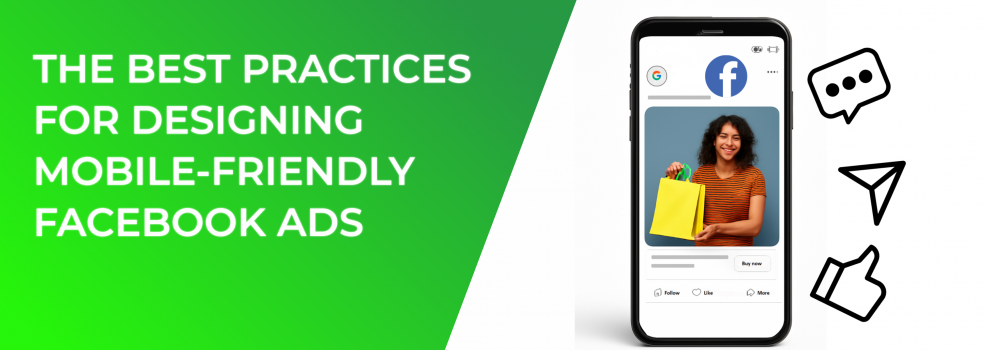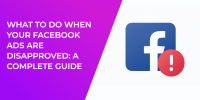Mobile devices are definitely the primary way people engage with Facebook. Whether they’re scrolling through their news feed, watching videos, or browsing through ads, ensuring your Facebook ads are mobile-friendly is critical to capturing your audience’s attention. But how do you design an ad that not only grabs attention but also converts on mobile? Here’s a comprehensive guide to the best practices for Facebook ad optimization.
1. Keep It Simple and Clear
When designing Facebook ads for mobile, less is often more. Mobile screens are smaller, and users tend to scroll quickly. To ensure your ad stands out, focus on a single message. The limited space on mobile means you need to get to the point quickly and effectively.
-
Use short and compelling text: Mobile users often don’t have the time or patience to read long paragraphs. Stick to concise, impactful language. Focus on the key benefit or solution your product or service provides. A headline that’s no longer than 4-5 words will grab attention, while the body text should elaborate on the message but still remain short and easy to read. The Facebook ad copy should always be optimized to keep the reader’s attention.
Example: Instead of saying, “Get your hands on the best mobile phone plan that gives you unlimited data, free calls, and exclusive rewards," try “Get Unlimited Data & Free Calls!” This approach delivers the message instantly without overwhelming users with too much text.
-
Visual impact: The right visuals are crucial in mobile ad optimization. High-quality images or videos should be your go-to, as they immediately engage users. Ensure the visuals are optimized for mobile screens. This includes ensuring that they’re not too large or distorted when viewed on different mobile devices. You can use Facebook’s tool to preview how the image will appear on mobile.
Keep the visuals relevant to the message of your ad. If you’re promoting a product, show it in use rather than just displaying the product itself. This can help the audience imagine how the product fits into their own lives.
2. Optimize for Mobile Dimensions
Facebook ad optimization is all about making sure your ads are the right size and easily accessible on mobile. Mobile screens are smaller, so the aspect ratio and layout matter more than ever.
-
Aspect ratio matters: The recommended aspect ratio for mobile-friendly Facebook ads is 1:1 for square images and 4:5 for vertical ones. These ratios take up more screen space, making them more engaging for users. Mobile-first ads work best when they make full use of the screen real estate. Square images are easy to view on mobile feeds, while vertical images make better use of limited space, filling more of the user’s screen and catching their eye quicker. If you’re looking for more tips on Facebook ad formats, check out this ultimate guide.
Experiment with both square and vertical formats and monitor how each performs in terms of engagement. Some ads may perform better in one format over the other, so it’s worth testing these options regularly.
-
Test on various devices: Facebook’s mobile ad previews allow you to see how your ad will look on different devices. Take advantage of this tool to ensure that your ad looks great on both smartphones and tablets. Testing on different devices ensures your ad is consistently presented in a way that enhances the user experience, regardless of screen size.
3. Use Mobile-Friendly Call-to-Actions (CTAs)
Your call-to-action (CTA) should be clear and designed with mobile users in mind. On mobile, users interact with Facebook ads using their fingers, so your CTA must stand out and be easy to tap.
-
Keep it actionable and specific: Phrases like "Shop Now," "Learn More," "Sign Up," or "Get Started" work well because they’re concise and encourage immediate action. Mobile users are often on-the-go and are more likely to act if the action is simple and easy to understand.
It's important to use language that creates urgency without sounding pushy. Phrases like "Limited Time Offer" or "Hurry, Act Now" can motivate users to take action right away.
-
Button size and placement: The CTA button should be large enough for users to tap easily. A small or poorly placed button can frustrate users and drive them away. Place your CTA near the center of the ad so it is within the user's immediate view without having to scroll or zoom in. Ensure it contrasts with the rest of the ad so it stands out, making it easy for users to identify and click.
4. Leverage Facebook Pixel for Targeting
If you want to optimize your Facebook ad campaigns, use the Facebook Pixel. This tool tracks user actions on your website and allows you to retarget users who’ve engaged with your mobile ads. This targeting strategy increases the chances of conversion by serving ads to those who are more likely to take action.
-
Set up the Pixel: To make the most out of your Facebook ad optimization, create and install the Facebook Pixel on your website. This enables you to track conversions and improve your targeting. Retargeting ads are particularly effective because they reach an audience that has already shown interest in your product or service. For more insights on Facebook retargeting, visit this post here.
By tracking user actions, you can customize the messaging of your retargeted ads to address specific behaviors. For example, if someone adds a product to their cart but doesn’t complete the purchase, you can target them with an ad offering a discount or reminding them to finish the transaction.
5. Test Mobile Ad Performance Regularly
To ensure your ads continue to perform well on mobile, regular testing is crucial. A/B testing allows you to optimize your Facebook ad campaigns for better performance. For more on how to scale Facebook ads effectively, check out this article on the science of scaling Facebook ads.
-
Optimize campaign budget: Facebook's campaign budget optimization (CBO) lets Facebook decide where to allocate your budget within your campaign. This feature is especially helpful for mobile ads, as it ensures your ad spend is directed toward the best-performing ads. You can let Facebook automatically allocate your budget to the most effective ad set, maximizing ROI for your mobile campaigns.
CBO helps ensure that your mobile ads receive the best possible performance without requiring manual adjustments. This saves time and ensures that your budget is being used efficiently.
-
Monitor metrics: Mobile users may interact differently with ads than desktop users, so adjusting your strategy based on these insights is essential. Pay close attention to important metrics like click-through rate (CTR), conversion rate, and engagement. These KPIs will help you determine how well your mobile ads are performing and if changes are needed.
Don't just focus on CTR. An ad with a high CTR but low conversion rate might need adjustments to its landing page or CTA. Ensure you look at the full funnel to truly gauge performance.
6. Create Mobile-Specific Content
What works on desktop might not always work on mobile. For mobile devices, users prefer quick and digestible content. Video ads, short-form content, and carousel ads perform particularly well on mobile.
-
Short video ads: Mobile users have shorter attention spans compared to desktop users. Keep videos short, ideally under 15 seconds, as they will load quicker and are more likely to be watched all the way through. Focus on delivering your message quickly with captions, as many mobile users watch videos without sound.
Example: For a restaurant ad, start with a quick 2-second clip of the food, followed by a caption reading, "Delicious meals, delivered to your door." Follow up with a CTA like “Order Now” to drive immediate action.
-
Carousel ads: These allow users to swipe through multiple images or videos. Carousel ads are especially effective for showcasing multiple products or telling a story in bite-sized pieces, perfect for the mobile experience. Use carousel ads to highlight a product lineup or show various features of a single product. This format allows users to interact directly with the ad by swiping, increasing engagement and time spent with your content.
Mobile-friendly content like short videos and carousel ads perform better on mobile devices, driving higher engagement.
7. Monitor Your Ad’s Load Time
A critical factor in mobile ad optimization is how quickly your ad loads. Slow-loading ads can cause users to abandon your content before it even finishes loading. Speed is essential for mobile ads, as mobile users have limited patience.
-
Optimize your images and videos: Make sure the files are not too large. Use Facebook’s recommended ad image and video sizes to ensure they load quickly without sacrificing quality. Compression tools can help reduce the size of your media files while maintaining visual integrity.
You can also use tools like Google’s PageSpeed Insights to test the loading speed of your landing pages and make necessary adjustments.
-
Responsive landing pages: Ensure that the landing page you link to is also mobile-optimized. A responsive design ensures that the page adapts seamlessly to different screen sizes, making it easier for users to navigate and complete conversions on mobile devices.
Conclusion
Designing Facebook ads that are mobile-friendly is a key part of optimizing your Facebook ad campaigns. By keeping your ads simple, clear, and visually appealing, and by leveraging tools like the Facebook Pixel and campaign budget optimization, you can ensure that your ads reach the right audience in the most effective way possible.
Remember, mobile-first experiences are the future, and by creating ads that work perfectly on mobile devices, you'll increase your chances of higher engagement and better conversions. Start optimizing your mobile-friendly Facebook ads today, and watch your campaigns thrive.

